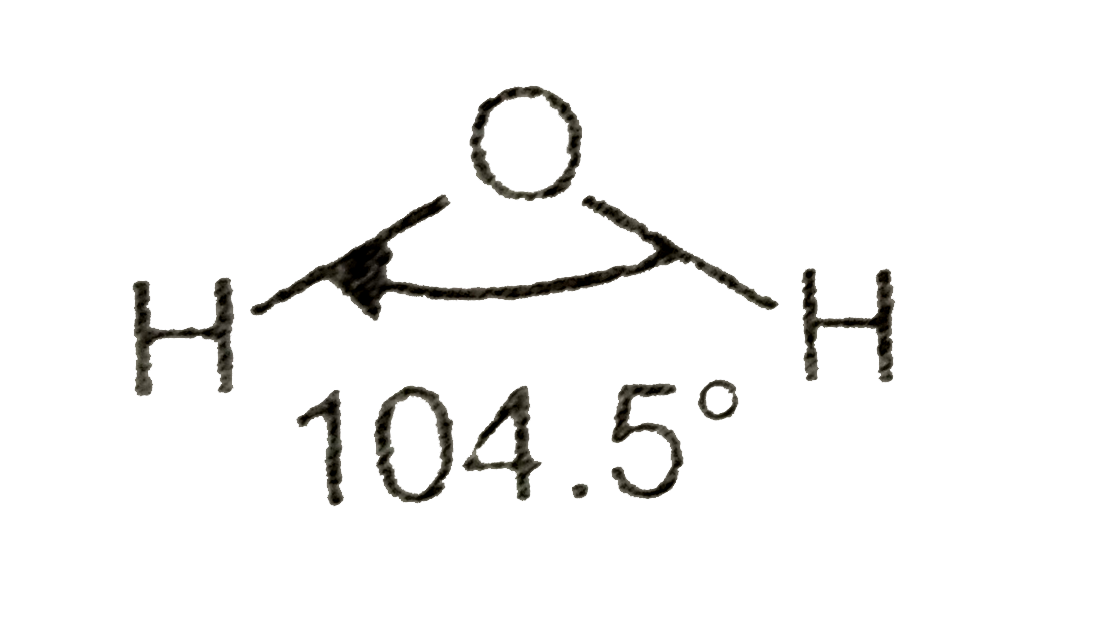POLARITY OF BONDS- DIPOLE MOMENT
Step by step video & image solution for POLARITY OF BONDS- DIPOLE MOMENT by Chemistry experts to help you in doubts & scoring excellent marks in Class 11 exams.
Updated on:21/07/2023Similar Questions
Meaning OF Dipole Dipole Moment || Factors Affecting Dipole Moment || Resultant Dipole Moment || Bond pair Moment and Lone pair Moment || Short Trick with Class Illustration
View SolutionElectric Dipole moment is a vector quantify . If a compound contain more than one polar bond then , the net electric dipole moment is equal to vector sum of individual dipole moment .
e.g., In H2O
μ=1.84D

Out of following which has the highest dipole moment
View Solution
Knowledge Check
Statement-1: Dipole moment of H2O is more than that of OF2
Statement-2: In H2O , the resultant bond dipole of O-H bond and the resultant lone pair moment are in opposite direction.AStatement -1 is true, Statement-2 is true and statement-2 is correct explanation for statement -1.BStatement-1 is true, statement-2 is true and statement-2 is NOT the correct explanation for statement-1CStatement-1 is true, statement-2 is falseDStatement-1 is false, statement-2 is true.Statement-1 : Dipole moment of H2O is more than that of OF2.
Statement-2 : In H2O, the resultant bond dipole of O−H bond and the resultant lone pair moment are in opposite direction.AStatement-1 is True, Statement-2 is True, Statement-2 is a correct explanation for Statement-1.BStatement-1 is True, Statement-2 is True, Statement-2 is NOT a correct explanation for Statement-1.CStatement-1 is True, Statement-2 is False.DStatement-1 is False, Statement-2 is True.Statement-1 : Dipole moment of NF3 is less than that of NH3.
Statement-2 : Polarity of N−F bond is less than that of N−H bond.AStatement-1 is True, Statement-2 is True, Statement-2 is a correct explanation for Statement-1.BStatement-1 is True, Statement-2 is True, Statement-2 is NOT a correct explanation for Statement-1.CStatement-1 is True, Statement-2 is False.DStatement-1 is False, Statement-2 is True.
A polar covalent bond is formed between the two elements of different electronegativies. The polarity of a bond depends on the electronegativity difference, the boiling atoms and also on the shape of the molecule.
A-B Let xA and xB are the electronegativites of bonding atoms A and B then, percentage ionic character of the bond can be calculated, as
% ionic character =21|xA−xB|+3.5|xA−xB|2 Dipole moment of the bond (μ) depends on the bond length and the polarity of the bond.
μ=q×d
Here, q = charge of the dipoles
d = bond length
It is observed that the dipole moment increases with increase in the inductive effect. Answer the following questions as indicated: Select code (a) if the statement is true and code (b) if the statement is false.
The dipole moment of CH3−X bond lies in the following sequence:
CH3−I<CH3−Br<CH3−CI
True (a) False (b)
View SolutionBond Angle and Comparison OF Bond Angle || Bond Energy || Hybridisation in Solid State || Dipole Moment
View SolutionElectric Dipole moment is a vector quantify . If a compound contain more than one polar bond then , the net electric dipole moment is equal to vector sum of individual dipole moment .
e.g., In H2O
μ=1.84D

The compound has molecular formula H2O, dipole moment of the compound is-
View SolutionAssertion (A): In dilute benzene solutions, equimolar addition of R3N and HCI produce a substance with a dipole moment. In the same solvent, equimolar addition of R3N and SO3 produce a substance having an almost identical dipole moment.
Reason (R) : Both HCI and SO3 are Lewis acids and can react with the amine base to form polar substances which undergo ionic dissociation in a solvent sufficiently more polar than benzene.
Moreover, (N−S) bond is a more polar bond.
View SolutionAssertion : Ethers have specific dipole moment values
Reason : The C-O bond is polar nature.
View Solution
